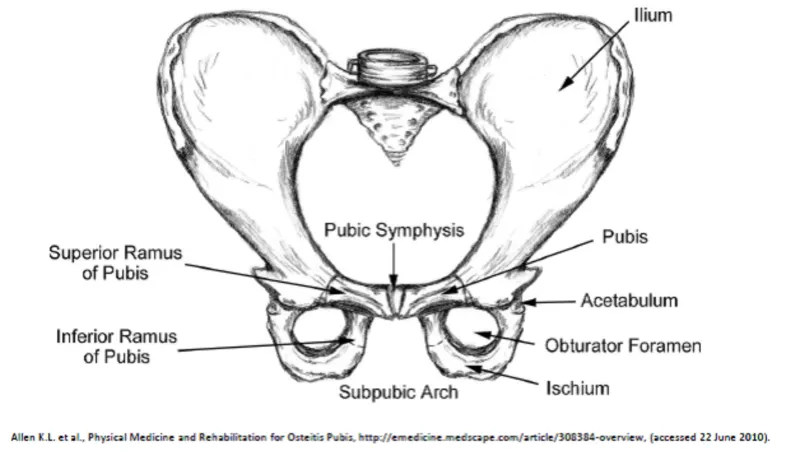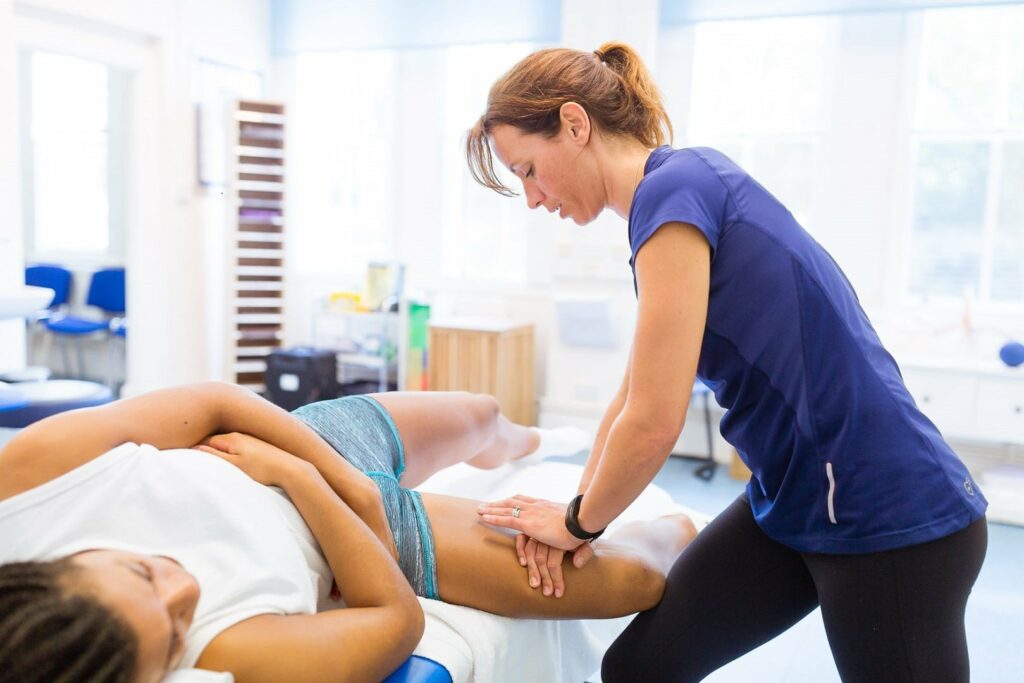What is osteitis pubis?
Osteitis pubis (OP) is characterised as pain in the pubic symphysis at the front of the pelvis. The pelvis forms a ring with the sacrum at the back and the pubic bone at the front. Where the two halves of the pelvis join at the front is known as the pubic symphysis.
The pubic symphysis is a thin joint which under normal circumstances has very minimal motion. In osteitis pubis, or with other types of groin pain, the pubic symphysis can be slightly out of line, with one side higher or lower, or further forward or back than the other. Pain in this area can inhibit the muscles around the pelvis, altering the stability of the pelvic ring, resulting in more torsional forces through the pubic symphysis during movement and walking. It is this malalignment and excess movement that can result in inflammation and pain.
Osteitis pubis can be very debilitating for sportsmen and women, and for women during and after pregnancy. In addition to being very painful, it can cause muscle inhibition, and feelings of weakness and loss of power. It can also result in a loss of technique and performance.

Causes of Osteitis Pubis
Osteitis pubis can have a number of different causes and it is this that can make it a difficult problem to get rid of. We have found that the more complex and resistant cases of osteitis pubis have many causative factors, and that unless the physiotherapist is able to identify and address most or all of them, the outcome can be poor, resulting in chronic pain, especially in the sporting population.
Causes of osteitis pubis can include the following, which are also factors that can prevent or slow down the healing process, causing ongoing pain:
- Sports activities (football and rugby are most common)
- Surgical procedures (gynaecological or abdominal, hernia repairs)
- Pregnancy and childbirth
- Trauma/injury
- Spinal malalignment
- Pelvic malalignment (the pubic symphysis itself may be out of line)
- Leg length difference
- Foot biomechanics
- Technique- walking and /or running
- Poor flexibility
- Poor muscle strength and recruitment – although muscles can also become overactive and therefore short and tight
- Breathing issues
- Reduced core strength and control of the spine and pelvis during activity
- Poor glut strength and overuse of adductors
- Visceral organs (organs in the abdominal or pelvic cavity) may become affected, which can refer pain, or cause pelvis malalignment
- Hip problems
- Poor balance
Symptoms of Osteitis Pubis
The most common symptom of osteitis pubis is pain over the front of the pelvis. The pain is often central, although can be worse on one side than the other. It can also radiate down into one thigh or into the groin. It is possible to have similar pain in the groin without having full osteitis pubis and it would still be treated in a similar way.
Other symptoms can include:
- Weakness
- Limping gait
- Pain during sport
- Change of technique through inhibition of muscles
- A feeling of generally being “crooked”
- Pain in the groin
- Pain in the lower abdomen
Getting Rid of Osteitis Pubis
At CSPC we are experienced in treating osteitis pubis (OP). Generally, when a client presents with osteitis pubis or chronic groin strain, there is usually a mitigating factor that is preventing it from healing. It may be that the joint itself is out of line for some reason, or that the muscles that function around the pelvis are too tight, too weak or overactive. This can cause changes in the way you move or stand.
Invariably it is this that is not allowing the area to heal and the resultant pain in the pubic symphysis then causes further dysfunction in the body, as it tries to compensate.
It is only by realigning the spine and pelvis and stretching and/or strengthening the muscles around the trunk, pelvis and lower limb, and retraining how we use those muscles, and the way we walk or run, that we can start to allow the painful area to heal. This is sometimes why cortisone injections may not work in the area (although they can be effective if the area is aligned and the issues above have been addressed). In our experience, it is better to have a cortisone injection, if one is needed, once all causative factors have been addressed, as the result will be more likely to be successful.
It is always important to find out why the osteitis pubis came on initially. We have seen some cases where the groin pain has arisen because of issues with the shoulder or neck, for example.

Treatment of Osteitis Pubis
The physiotherapist will take a thorough case history and will assess all of the areas described above.
Treatment will then begin to address these issues, aiming to help realign the spine and pelvis, to reduce pain and normalise the way you move.
Treatment can include:
- Spinal and pelvic alignment work
- Muscle energy techniques
- Soft tissue work and stretching
- Myofascial release
- Lower limb and core muscle strengthening
- Referral to podiatry if necessary for leg length assessment and biomechanical analysis
- Breathing retraining
- Postural analysis
- Retraining of walking and running technique
- Retraining of technical skills
- Balance retraining
- Visceral work if required
Treatment of osteitis pubis is most successful, particularly in the more chronic cases, if all of the above factors are taken into account and addressed if required. We have had a large amount of success in treating osteitis pubis at CSPC by treating it in this way, and with the greatest chance of avoiding recurrence. With the high-level sportsperson, we may also have to retrain running technique, and the way they move during their sport, for example around a football pitch.
We frequently see patients with osteitis pubis who have also developed issues with breathing, which further exacerbates symptoms and movement dysfunctions, which must also be retrained. This may happen if the patient has started to breath hold to brace around the trunk, overusing the abdominal muscles to try to stabilise the pubic symphysis.
Preventing Recurrence
If osteitis pubis and groin pain are treated by addressing all of the causes and not just the symptoms, there is a greater chance that the injury will not return, or if it does, it will not be as bad as it was initially. Most of the resistant cases are caused by problems with technique, biomechanics, visceral issues, surgeries, accidents and breathing issues. By being thorough and addressing as many of the issues as possible, the sportsperson should be able to return to high level sport, often performing at a higher level, as many of these issues have been present for years, causing other minor injuries, until they result in this major injury, which then needs to be fully addressed and rehabilitated.
Pregnancy And Osteitis Pubis
Osteitis pubis is very common in pregnant women and women post pregnancy. During pregnancy, a hormone called relaxin is released immediately, which helps to prepare the ligaments in the pelvis for birth. Relaxin starts to affect the ligaments of the pelvis from six weeks, and reaches it’s peak at twelve weeks. This high level continues throughout pregnancy and not only affects the ligaments around the pelvis, but also affects all the other ligaments in the body, causing there to be more joint play in all joints. The pubic symphysis and sacroiliac joints are particularly affected by relaxin. This laxity in the ligaments around the pelvis, hips and feet will alter the lower limb biomechanics, which further affects the stability of the pelvis, and this can result in pain. More specific advice for pelvic pain in pregnancy will be given on the pages on pregnancy on this website.
Advice for sufferers of Osteitis Pubis
MEET THE TEAM
Constantly challenging ourselves to be the best
See why patients
love CSPC Physiotherapy



